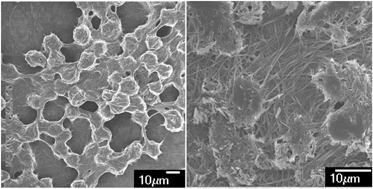Effects of carbon nanomaterials on the aggregation of a bi-oxadiazole derivative (BOXD-T8) in DMF and its gel properties†
Abstract
Two different carbon nanomaterials (CNMs), single-walled carbon nanotubes (SWNTs) and graphene oxide (GO), were successfully incorporated into a bi-1,3,4-oxadiazole derivative (BOXD-T8) in DMF and gel. Molecules of BOXD-T8 self-assembled to H- and J-aggregates in DMF within moderate concentration, and the ratio of H- and J-aggregates could be manipulated simply by changing the concentration. Energy transferred from H-aggregates to outputting CNMs may have been involved due to the incorporation of CNMs. Furthermore, the incorporation of SWNTs is better to induce the aggregation of BOXD-T8, while GO is better to induce the formation of J-aggregation, which resulted in a lower critical gelation concentration (CGC) and different morphologies compared to those of the corresponding pure BOXD-T8 organogel. The SEM morphologies showed that SWNTs-containing hybrid xerogel consisted of spherical aggregates derived from the entanglement of fibers. In contrast, both graphene sheets and entangled fibers were observed for GO-containing hybrid xerogels. In addition, the composite gel showed improved mechanical properties due to the physical enhancement effects of the incorporated CNMs as rigid materials in the organogel network.


 Please wait while we load your content...
Please wait while we load your content...